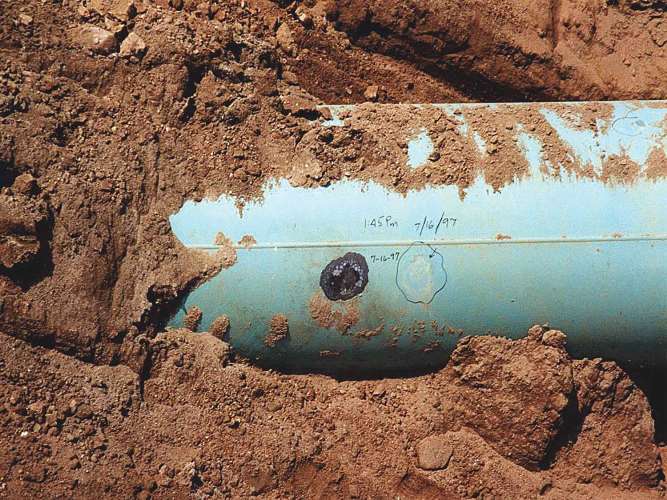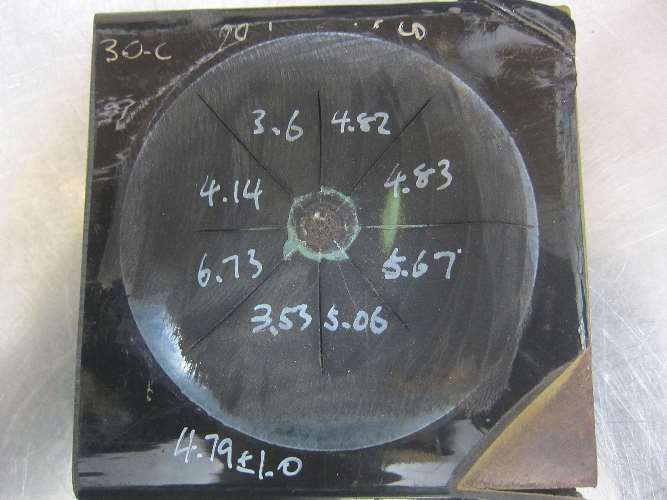Oil and gas pipelines are generally protected from corrosion by a barrier coating and cathodic protection (CP) system, a combination that is mandated by governmental regulations in many countries. Coatings for pipelines, such as fusion-bonded epoxy (FBE) and three-layer polyethylene (3LPE), generally provide excellent corrosion protection. In the event that the coating is damaged or degraded and the bare steel substrate is exposed, the pipeline is still protected from corrosion by CP.
According to NACE International member Dennis Wong, technology group manager—Research and Development with ShawCor, Ltd. (Toronto, Ontario, Canada) and vice chair of NACE Task Groups (TGs) 470—Cathodic Disbondment Test for Coated Steel Structures Under Cathodic Protection and 520—Pipeline Coating Peel Strength Test, the most important factor for preventing corrosion-related oil and gas pipeline failures is the use of a coating with excellent barrier properties (to prevent the ingress of corroding species such as oxygen and water) and mechanical strength (to resist damage in the service environment).
During the service life of the pipeline, the coating has to maintain its integrity under operating environments and in the presence of CP. The coating also needs to be a good electrical/electrolytic insulator to isolate the metal substrate from direct contact with the electrolyte, and have excellent electrical resistance to prevent any electrochemical reactions on the metal surface of the pipeline. A damaged coating that exposes bare metal areas or an aging coating that has degraded and experienced a brittle fracture renders the pipe surface susceptible to the ingress of moisture, oxygen, and other corroding species, and a functional CP system capable of meeting the current demand needed for corrosion protection will be required.
In his presentation, “Compatibility of Pipeline Coatings with Cathodic Protection,” given during the Protective Coating Technology Forum at CORROSION 2015 in Dallas, Texas, Wong discusses the basic principles of corrosion protection with coatings and CP, and the attributes of an effective pipeline coating. He notes that in the United States, the Code of Federal Regulations (CFR), specifically 49 CFR 192.455,1 states that each buried or submerged pipeline installed after July 31, 1971 must be protected against external corrosion with an external protective coating that meets the requirements of 49 CFR 192.461,2 and it must have a CP system designed to protect the pipeline installed and placed in operation within one year after completion of construction.
Electrical Resistance and Shielding
According to 49 CFR 192.461, each external protective coating that is applied for external corrosion control, whether conductive or insulating, must have sufficient adhesion to the metal surface to effectively resist underfilm migration of moisture; be sufficiently ductile to resist cracking; have sufficient strength to resist damage due to handling and soil stress; and have properties that support any supplemental CP. Additionally, if the external protective coating is an electrically insulating type, it must also have low moisture absorption and high electrical resistance. Wong comments that in general, an electrically insulating protective coating with insulation resistance of 106 Ω-m2 is good; and, depending on the service conditions, a coating with a minimum resistance of 104 Ω-m2 is acceptable.
“Obviously, in this scenario, it is very difficult for cathodic protection current to go through the coating itself,” Wong says, noting that if the coating is not damaged, it should have high enough electrical resistance to prevent any current transport through the coating so that electrochemical reactions don’t occur on the metal surface and initiate corrosion. A good coating will shield electrical current, so all good coatings will shield CP, he explains. “If there is a coating holiday, then it’s a different scenario,” Wong comments. A holiday or discontinuity in a coating is a small defect that is frequently very minute and not readily visible, such as a pinhole, void, crack, thin spot, foreign inclusion, or contaminant in the coating film. When a coating holiday or degradation provides a pathway for corrosive species to reach the metal substrate, Wong notes, the CP system should be capable of providing enough continuous current to polarize the steel surface to a potential that stops the oxidation of the steel. A coating with a holiday may disbond and the metal substrate can experience corrosion issues if the CP current is not adequate.
Wong defines shielding as high-resistance or nonconducting materials preventing CP current from reaching the structure to be protected, or low-resistance material diverting the current away from the structure to be protected. He emphasizes that many times cathodic shielding is not a coating issue, but rather an environmental or a CP system design issue—such as soil that is very resistive or an anode bed that is too far away—that prevents the appropriate amount of CP current from reaching the vulnerable metal surface. The term “nonshielding coating” is very misleading, he adds. “FBE is considered nonshielding in the United States, but the data I presented and the data from FBE suppliers clearly show that it will not allow enough CP current to pass through to achieve the protective level,” he says. “If a coating allows enough CP current to pass through it for protection of the underlying metal, then it defeats the purpose of a barrier coating and is not needed.” For a buried pipeline, shielding of a CP system with remote anode beds can be caused by rocky soils, wet and dry seasons, foreign metallic structures in the path, shorted casings, etc. A well-designed CP system will ensure an uninterrupted current supply to areas on a structure where the coating is damaged so corrosion issues will be minimized. The current requirement to achieve protection, which is generally about 10–5 A/cm2, Wong says, depends on the resistivity of the environment as well as the conductivity of the electrolyte and its oxygen content.
Cathodic Disbondment
Cathodic disbondment is the destruction of adhesion between a coating and the coated surface due to cathodic reaction products.3 If the coating does not have any defects, then cathodic disbondment typically will not occur. If there is a coating holiday/discontinuity or other defect, however, CP current will pass into the metal at the coating defect, resulting in a highly alkaline environment due to the formation of hydroxyl groups at the cathode (steel) surface. If a coating is not stable in the CP environment, the highly alkaline environment coupled with the polarized potential can cause the coating to lose adhesion and disbond from the substrate. The amount of current flow (current density) is determined by the amount of current available and the size of the coating defect. As the defect gets larger, the current flow increases and more of the coating is pushed away from the metal. This can result in rapid disbondment and coating breakdown.

Wong notes that coating disbondment doesn’t always indicate a corrosion problem, commenting that pipeline operators have identified areas of coating disbondment in underground pipelines where corrosion is not a problem. “Sometimes there will be disbondment, but that doesn’t mean corrosion will automatically occur,” he says. “If the coating doesn’t allow oxygen and water to go through, there will not be corrosion. If the coating does let water and oxygen pass through, then there will be corrosion, and you will need CP current there, too, for protection.” He refers to field experiences reported in literature that illustrate various corrosion scenarios with disbonded coatings. For example:
• Coating disbondment with no discontinuities in the coating typically results in minimal corrosion issues as long as the coating’s resistance is high and permeability for corrosive species (water, oxygen, and chloride ions) is low. In field conditions, a “failure friendly” coating such as FBE has been found to have corrosion issues, while a fully disbonded 3LPE coating without mechanical damage did not have any corrosion problems.4
• A disbonded coating that has discontinuities, but the coating is tightly bound to pipe, does not normally experience corrosion issues as long as the CP current is greater than the oxygen diffusion into a crevice.
• A disbonded coating with brittle fracture allows CP penetration to achieve protective potentials.
• A disbonded tape coating loosely wound on a pipe allows free electrolyte exchange with the environment, and corrosion and stress corrosion cracking (SCC) have been observed.
These observations illustrate that it is possible to polarize areas under disbonded coatings to protective potential levels, and a protective potential can be achieved in crevices as deep as 1 m as long as the CP current is greater than the oxygen diffusion rate.
Tests
To determine if a coating is formulated to resist disbondment underneath the coating and is compatible with CP (i.e., it will be stable in the CP environment), one of the basic checks is to test the coating’s disbondment resistance. Another basic test is the determination of a coating’s resistivity, Wong says. Electrochemical impedance spectroscopy (EIS) and conductivity cell tests have gained acceptance as methods to determine a coating’s compatibility with CP. EIS allows a quantitative analysis of several coating properties without affecting the coating and its performance. It also facilitates detection of changes in a coating’s capacitive and resistive behavior as a result of changes in the coating film’s properties due to ingress of moisture, ionic species, and the formation of microcracks or micropores.
EIS measures electrochemical impedance by applying an alternating current (AC) potential to an electrochemical cell and then measuring the current through the cell. If a coating is beginning to degrade and allow corrosion activity at the steel surface, he says, this can be detected with the EIS test. The conductivity cell test places a coating film between two electrolytes and a potential is impressed across the coating film. Both tests demonstrate that any highly resistant coating will not allow CP current to pass through it, Wong comments.
Within the past year, NACE TG 470 published a new cathodic disbondment test method, TM0115-2015,3 for coated steel structures under CP. This standard test method specifies procedures to evaluate cathodic disbondment resistance of coating systems under CP for steel structures such as buried or submerged pipelines and tanks. This standard is intended to be used during the selection of protective coating systems for use under CP, and takes all test parameters into consideration.

“Cathodic disbondment testing started quite a long time ago, and there are various test methodologies in different parts of the world with different variations,” Wong explains. The goal behind TM0115-2015 is that everyone will use the same test methodology to do cathodic disbondment testing, so tests from different parts of the world are comparable, he says.
The new NACE test method uses an accelerated electrochemical test procedure for determining nonmetallic protective coating systems’ comparative resistance to cathodic disbondment when they are applied to the exterior of steel pipes and structures buried in soil or submerged. The test method is intended to cover all service temperatures, from ambient to elevated temperatures, and provides guidance on test specimens, sample preparation, the test solution and apparatus setup, the actual test procedure, disbondment evaluation, and reporting the test results. When using this test method, results obtained can help rank candidate coating systems by their cathodic disbondment resistance at different service temperatures. The standard test method is not intended to simulate field conditions or predict service life.
References
1 U.S. Code of Federal Regulations (CFR) Title 49, Part 192.455, “External corrosion control: Buried or submerged pipelines installed after July 31, 1971” (Washington, DC: Office of the Federal Register, 2010).
2 U.S. Code of Federal Regulations (CFR) Title 49, Part 192.461, “External corrosion control: Protective coating” (Washington, DC: Office of the Federal Register, 2011).
3 NACE Standard TM0115-2015, “Cathodic Disbondment Test for Coated Steel Structures Under Cathodic Protection” (Houston, TX: NACE International, 2015).
4 M. Roche, “The Problematic of Disbondment and Corrosion with Pipeline Coatings,” 15th PRCI-EPRG-APIA Joint Technical Meeting on Pipeline Research, held May 1719, 2005 (Falls Church, VA: PRCI, 2005).